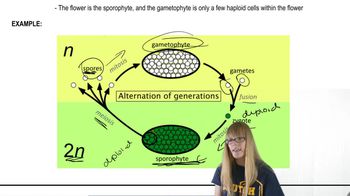Table of contents
- 1. Introduction to Genetics51m
- 2. Mendel's Laws of Inheritance3h 37m
- 3. Extensions to Mendelian Inheritance2h 41m
- 4. Genetic Mapping and Linkage2h 28m
- 5. Genetics of Bacteria and Viruses1h 21m
- 6. Chromosomal Variation1h 48m
- 7. DNA and Chromosome Structure56m
- 8. DNA Replication1h 10m
- 9. Mitosis and Meiosis1h 34m
- 10. Transcription1h 0m
- 11. Translation58m
- 12. Gene Regulation in Prokaryotes1h 19m
- 13. Gene Regulation in Eukaryotes44m
- 14. Genetic Control of Development44m
- 15. Genomes and Genomics1h 50m
- 16. Transposable Elements47m
- 17. Mutation, Repair, and Recombination1h 6m
- 18. Molecular Genetic Tools19m
- 19. Cancer Genetics29m
- 20. Quantitative Genetics1h 26m
- 21. Population Genetics50m
- 22. Evolutionary Genetics29m
20. Quantitative Genetics
Heritability
Problem 16
Textbook Question
In a line of cherry tomatoes, the average fruit weight is 16 g. A plant producing tomatoes with an average weight of 12 g is used in one self-fertilization cross to produce a line of smaller tomatoes, and a plant producing tomatoes of 24 g is used in a second cross to produce larger tomatoes.What is the selection differential (S) for fruit weight in each cross?
 Verified step by step guidance
Verified step by step guidance1
Understand the concept of selection differential (S): It is the difference between the mean phenotype of the selected parents and the mean phenotype of the original population. In this case, it measures how much the average fruit weight of the selected parents deviates from the average fruit weight of the original population.
Identify the average fruit weight of the original population, which is given as 16 g.
For the first cross (smaller tomatoes): Determine the average fruit weight of the selected parent, which is 12 g. Calculate the selection differential (S) using the formula: , where is the average weight of the selected parent and is the average weight of the original population.
For the second cross (larger tomatoes): Determine the average fruit weight of the selected parent, which is 24 g. Use the same formula to calculate the selection differential (S): .
Interpret the results: The selection differential (S) will indicate how much the selected parents deviate from the original population in terms of fruit weight. This value is important for understanding the strength of selection in each cross.
 Verified video answer for a similar problem:
Verified video answer for a similar problem:This video solution was recommended by our tutors as helpful for the problem above
Video duration:
2mPlay a video:
Was this helpful?
Key Concepts
Here are the essential concepts you must grasp in order to answer the question correctly.
Selection Differential (S)
The selection differential (S) is a measure of the difference between the mean phenotype of the selected individuals and the mean phenotype of the entire population. It quantifies the extent to which selected individuals differ from the average, indicating the strength of selection applied. In this context, S can be calculated by subtracting the average fruit weight of the selected plants (12 g or 24 g) from the average fruit weight of the original population (16 g).
Recommended video:
Guided course

Artificial Selection
Phenotypic Variation
Phenotypic variation refers to the observable differences in traits among individuals in a population, which can be influenced by genetic and environmental factors. Understanding phenotypic variation is crucial for predicting how traits like fruit weight can change over generations due to selection. In this scenario, the variation in fruit weight among the selected plants and the original population is essential for calculating the selection differential.
Recommended video:
Guided course

Genomic Variation
Self-Fertilization in Plants
Self-fertilization is a reproductive strategy where a plant fertilizes its own ovules with its own pollen, leading to offspring that are genetically similar to the parent. This method can stabilize certain traits within a population, making it useful for producing lines with specific characteristics, such as smaller or larger tomatoes in this case. Understanding self-fertilization helps in predicting the inheritance patterns of selected traits in subsequent generations.
Recommended video:
Guided course

Formation of Plant Gametes

 7:04m
7:04mWatch next
Master Calculating Heritability with a bite sized video explanation from Kylia
Start learningRelated Videos
Related Practice
Textbook Question
In Nicotiana, two inbred strains produce long (PL) and short (PS) corollas. These lines are crossed to produce F₁, and the F₁ are crossed to produce F₂ plants in which corolla length and variance are measured. The following table summarizes mean and variance of corolla length in each generation. Calculate H² for corolla length in Nicotiana.Generation Mean Corolla Length (mm) VariancePL 85.75 4.21PS 43.15 2.89F₁ 62.26 3.62F₂ 67.37 38.10
344
views
